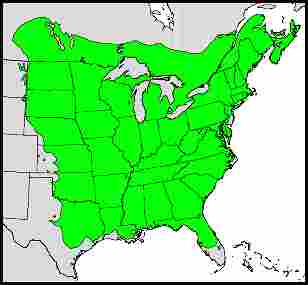American Elm
(Ulmus americana)
At one time the American Elm was the most popular large landscaping tree in the eastern United States. For decades its beautiful vaselike silhouette was a familiar sight in yards and parks. But beginning in the 1930's, an accidentally introduced fungus called Dutch Elm Disease (Ophiostoma ulmi) spread across the land and killed more than 95% of the existing trees.
But some trees did survive. Such individuals, found at scattered locations throughout the old range, apparently have a natural resistance to the disease. Their survival provides hope that the species can eventually reclaim its position among the country's pre-eminent trees. In fact the effort to restore it is already well underway, and you can participate by planting special high-resistance strains on your own property.
Recently-introduced resistant strains include the named varieties New Harmony, Delaware #2, Valley Forge, and Washington. Because they are new, supplies may be limited. Perhaps more readily available is a group of six closely-related strains called American Liberty Elms. They were introduced in the 1980's by the Elm Research Institute. But the variety with the longest proven record of blight resistance is an old strain named Princeton. It was first planted in the 1920's, but its resistance wasn't generally recognized until the 1990's. Some of the original trees can still be seen in Princeton, New Jersey.
There are other resistant forms being marketed, but some are hybrids with other species of elm. To make sure that you get the real thing, check carefully before making a purchase.
The resistant varieties should make excellent landscaping plants. American Elm is a tough fast-growing tree with good adaptability and cold-hardiness. It can grow in most soil types, wet or dry, and in sun or partial shade. However, you shouldn't plant it near driveways or sidewalks because its invasive roots can cause lifting.
Some of the surviving trees from the old era have only a partial resistance to the disease, and though still alive, may be succumbing at a slow rate. Such specimens can often be maintained in a healthy state by giving them periodic injections of a fungicide. (A tree specialist can do this.) Anyone who owns such a tree should consider taking this action, since DNA from the plant or its offspring could eventually be used in the creation of new strains. It is important to save as much of the species' genetic pool as possible, because greater diversity gives it more ability to resist new diseases and adapt to changing environments. For this reason, researchers want to develop a large number of resistant strains.
American Elm seeds are eaten by a number of birds and mammals, including Wood Ducks, Wild Turkey, Purple Finches, Rabbits, and Squirrels. The tree is also a favorite nesting site for the Baltimore Oriole.
Other Information
Scientific Name: Ulmus americana
Common Names: Elm, American Elm
Plant Type: Large deciduous tree
Height: Up to 100 feet
Cultivation Zones: 3 to 9
Native Range: Most of the eastern and central United States. See distribution map below.
Distribution Map

Range Map Source: U.S. Forest Service. (See General Note C)
Cultivation: Plant away from driveways, sidewalks, and buildings. If possible, place it in good soil in a sunny location, and water during dry spells until established. Be aware that rabbits can completely destroy a young plant, so give it protection for the first few years. Go to Cultivation for more information.
|

